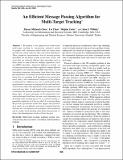| dc.contributor.author | Chen, Zhexu (Michael) | |
| dc.contributor.author | Chen, Lei | |
| dc.contributor.author | Cetin, Mujdat | |
| dc.contributor.author | Willsky, Alan S. | |
| dc.date.accessioned | 2012-10-04T13:16:10Z | |
| dc.date.available | 2012-10-04T13:16:10Z | |
| dc.date.issued | 2009-08 | |
| dc.date.submitted | 2009-07 | |
| dc.identifier.isbn | 978-0-9824-4380-4 | |
| dc.identifier.uri | http://hdl.handle.net/1721.1/73586 | |
| dc.description.abstract | We propose a new approach for multi-sensor multi-target tracking by constructing statistical models on graphs with continuous-valued nodes for target states and discrete-valued nodes for data association hypotheses. These graphical representations lead to message-passing algorithms for the fusion of data across time, sensor, and target that are radically different than algorithms such as those found in state-of-the-art multiple hypothesis tracking (MHT) algorithms. Important differences include: (a) our message-passing algorithms explicitly compute different probabilities and estimates than MHT algorithms; (b) our algorithms propagate information from future data about past hypotheses via messages backward in time (rather than doing this via extending track hypothesis trees forward in time); and (c) the combinatorial complexity of the problem is manifested in a different way, one in which particle-like, approximated, messages are propagated forward and backward in time (rather than hypotheses being enumerated and truncated over time). A side benefit of this structure is that it automatically provides smoothed target trajectories using future data. A major advantage is the potential for low-order polynomial (and linear in some cases) dependency on the length of the tracking interval N, in contrast with the exponential complexity in N for so-called N-scan algorithms. We provide experimental results that support this potential. As a result, we can afford to use longer tracking intervals, allowing us to incorporate out-of-sequence data seamlessly and to conduct track-stitching when future data provide evidence that disambiguates tracks well into the past. | en_US |
| dc.language.iso | en_US | |
| dc.publisher | Institute of Electrical and Electronics Engineers (IEEE) | en_US |
| dc.relation.isversionof | http://ieeexplore.ieee.org/xpls/abs_all.jsp?arnumber=5203742 | en_US |
| dc.rights | Article is made available in accordance with the publisher's policy and may be subject to US copyright law. Please refer to the publisher's site for terms of use. | en_US |
| dc.source | IEEE | en_US |
| dc.title | An Efficient Message Passing Algorithm for Multi-Target Tracking | en_US |
| dc.type | Article | en_US |
| dc.identifier.citation | Zhexu Chen, et al. "An efficient message passing algorithm for multi-target tracking" 12th International Conference on Information Fusion, 2009. FUSION '09. ©2009 ISIF | en_US |
| dc.contributor.department | Massachusetts Institute of Technology. Department of Electrical Engineering and Computer Science | en_US |
| dc.contributor.department | Massachusetts Institute of Technology. Department of Mechanical Engineering | en_US |
| dc.contributor.department | Massachusetts Institute of Technology. Laboratory for Information and Decision Systems | en_US |
| dc.contributor.mitauthor | Chen, Zhexu (Michael) | |
| dc.contributor.mitauthor | Chen, Lei | |
| dc.contributor.mitauthor | Cetin, Mujdat | |
| dc.contributor.mitauthor | Willsky, Alan S. | |
| dc.relation.journal | Proceedings of the 12th International Conference on Information Fusion, 2009. FUSION '09 | en_US |
| dc.eprint.version | Final published version | en_US |
| dc.type.uri | http://purl.org/eprint/type/ConferencePaper | en_US |
| dc.identifier.orcid | https://orcid.org/0000-0003-0149-5888 | |
| mit.license | PUBLISHER_POLICY | en_US |
| mit.metadata.status | Complete | |
